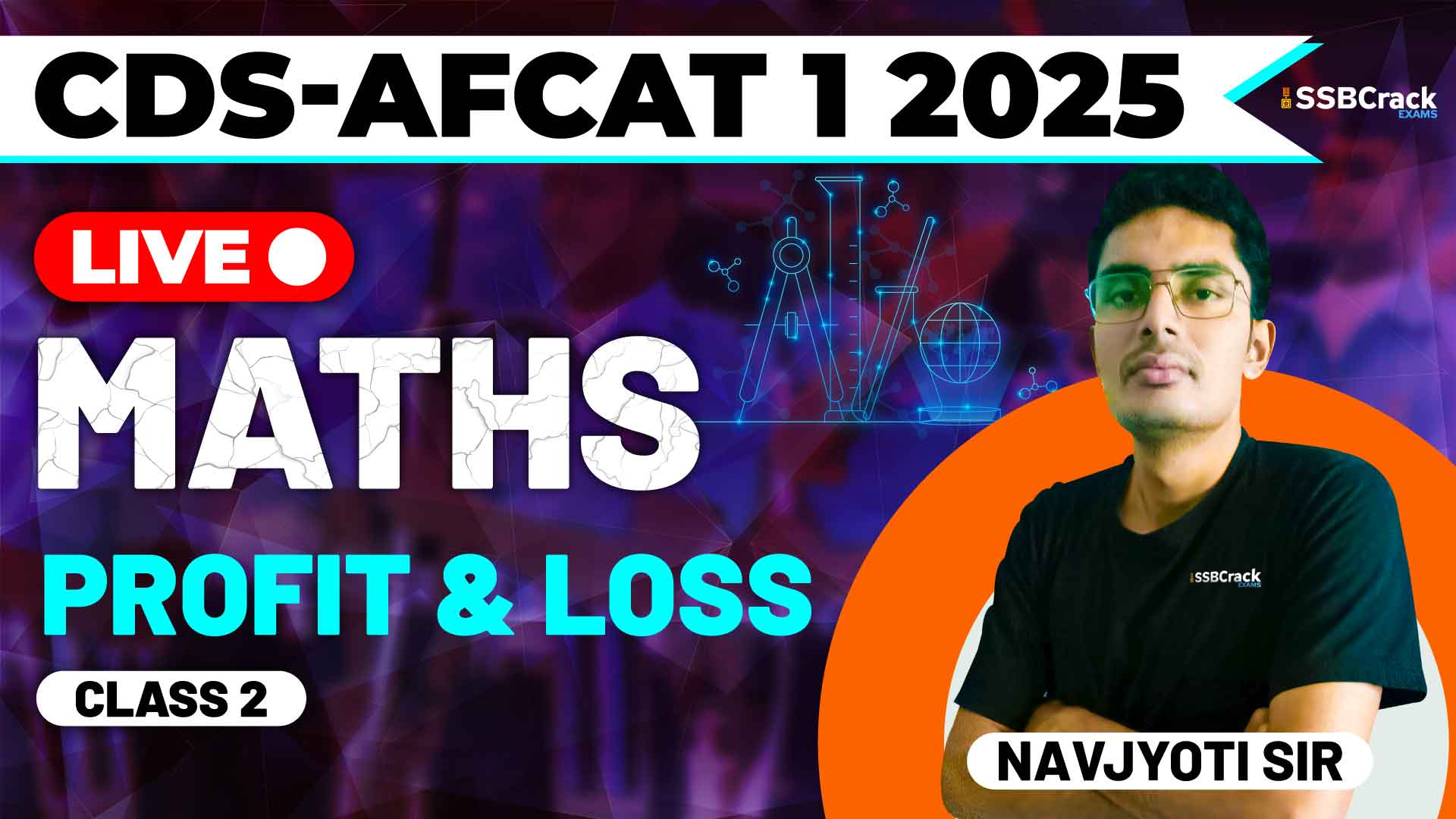In the context of competitive exams like the Combined Defence Services (CDS) and Air Force Common Admission Test (AFCAT), the mathematics section frequently includes questions on profit and loss. One of the more intricate parts of this topic involves concepts like marked price, mark-up percentage, discounts, cost price, profit percentage, and successive discounts. These elements are key in understanding how sellers price goods, offer discounts, and calculate overall profitability.
This blog will walk through the details of these sub-topics and present strategies for mastering them for the CDS and AFCAT exams.
Overview of the Topic
The concepts of profit and loss go beyond simply calculating the difference between selling price and cost price. Sellers often use marked price and discounts to attract customers, which complicates the calculations. In competitive exams, understanding how these concepts interrelate is essential for solving profit and loss problems efficiently.
Here’s a breakdown of the major sub-topics discussed in the class :
- Marked Price (MP):
The marked price is the initial price tagged on a product by the seller before any discount is applied. It’s the price that buyers first see when they consider purchasing an item. Sellers often mark up the cost price (CP) of an item to set the marked price, which provides room for offering discounts and still making a profit. - Mark-Up Percentage:
Mark-up refers to the amount added to the cost price to determine the marked price. The mark-up percentage is the ratio of the increase from the cost price to the cost price itself. This percentage shows how much the seller expects to gain before offering any discount. - Discount:
Discounts are reductions from the marked price given to customers. These are often used to incentivize purchases and clear out stock. In profit and loss questions, you’re typically asked to calculate the effective selling price after applying a discount or successive discounts. - Cost Price (CP):
Cost price refers to the original price paid by the seller to acquire a product before selling it to customers. The difference between the cost price and selling price, after accounting for any discounts, determines the profit or loss. - Profit Percentage:
Profit percentage is the amount of profit made on the cost price, expressed as a percentage. When discounts are applied, it’s important to calculate how they affect the final selling price and ultimately the profit made by the seller. - Discount Percentage:
Discount percentage is the reduction offered on the marked price. It’s important to know how to calculate the effective price after applying a discount, which in turn influences the seller’s profit or loss. - Successive Discounts and Overall Discount Percentage:
Successive discounts involve offering more than one discount on the marked price. For example, a seller may offer a 10% discount followed by an additional 5% discount. Understanding how to calculate the overall discount and its effect on the selling price is crucial, as successive discounts are common in exam questions.
Key Sub-Topics Explained
- Marked Price and Mark-Up Percentage
Marked price is usually higher than the cost price because sellers mark up the cost to ensure profitability. The mark-up percentage indicates how much higher the marked price is compared to the cost price. For example, a 20% mark-up on a product costing $100 results in a marked price of $120. This marked price is then used as a base for offering discounts. Understanding the mark-up concept is essential for solving questions where you need to calculate the marked price or find out the profit based on the marked price after offering discounts. - Discount and Discount Percentage
A discount is a reduction from the marked price, usually expressed as a percentage. If the marked price of a product is $200 and a discount of 10% is offered, the buyer pays $180. Discounts are a frequent part of exam questions, and it’s important to calculate how they affect the final price paid and the seller’s profit. - Successive Discounts and Overall Discount
Sometimes, a seller offers more than one discount in succession. For example, a product might be discounted by 20% first, and then an additional 10% discount might be applied to the reduced price. Successive discounts are not simply added together. Instead, the second discount is applied to the price after the first discount. This can be a tricky area for students, but with practice, calculating successive discounts becomes easier. - Profit, Loss, and Their Relation to Marked Price and Discounts
When a seller offers discounts, it reduces the selling price, which impacts the overall profit. If the selling price after discounts is still higher than the cost price, the seller makes a profit. Conversely, if the selling price drops below the cost price due to discounts, the seller incurs a loss. Exam questions will often provide details about the cost price, marked price, and discounts, and ask you to calculate the profit or loss percentage. Understanding the relationship between these variables is critical to solving such problems accurately.
Strategies to Master Profit and Loss for CDS and AFCAT Exams
To effectively prepare for the topic of profit and loss in these exams, consider the following strategies:
1. Understand the Relationships Between MP, CP, SP, and Discounts
One of the most important strategies is to understand how marked price, cost price, and selling price are connected through discounts and mark-ups. Practice different types of questions where you calculate selling price after applying one or more discounts, and how these affect profit margins.
2. Practice Successive Discounts Thoroughly
Successive discounts are a common area of confusion. Since successive discounts require applying the second discount to the reduced price rather than the marked price, it’s essential to understand this process well. Solve as many problems as you can to become familiar with the concept.
3. Memorize Common Discount and Profit Percentages
Just as you would memorize common percentage-fraction conversions, memorizing common profit and discount percentages helps solve problems quickly. Being able to instantly recognize the effect of, say, a 10% discount or a 25% profit on cost price will save time during the exam.
4. Work on Speed and Accuracy with Discounts
In exams like CDS and AFCAT, time management is crucial. Develop the ability to perform quick mental calculations when working with discounts and mark-ups. Practice with timed quizzes and past exam papers to improve your speed and accuracy.
5. Understand Real-Life Applications
Many profit and loss problems are framed in real-world contexts. Practicing word problems related to shopping discounts, product mark-ups, and successive discounts will help you understand the practical applications of these concepts. This, in turn, will make the exam problems more intuitive to solve.
6. Break Down Complex Problems Step by Step
Complex problems involving multiple steps, such as calculating profit after applying successive discounts, can seem daunting. Break them down into smaller steps, and solve each part one at a time. Focus on the logical flow: first find the selling price after discounts, then compare it to the cost price to determine profit or loss.
7. Practice with Past Papers and Mock Tests
Solving past papers and mock tests is one of the best ways to familiarize yourself with the type of profit and loss questions that appear in CDS and AFCAT exams. It also helps you identify any weak areas where you need to improve. Timed practice tests are especially useful for improving both speed and accuracy.
Conclusion
Profit and loss, especially with the added complexity of marked price, discounts, and successive reductions, is a critical topic for the mathematics section of the CDS and AFCAT exams. By understanding the relationships between cost price, selling price, and discounts, and by mastering the calculation of successive discounts and overall profit or loss percentages, you can solve these questions confidently.
The key to success lies in regular practice, understanding real-world applications, and working on time management. By following the strategies outlined here, you’ll be well on your way to mastering profit and loss questions for these competitive exams. Good luck with your preparation!



















